Preparation of Isotropic Carbon Fibers from Kerosene-Purified Coal Tar Pitch by Co-Carbonization with Pyrolysis Fuel Oil
Abstract
:1. Introduction
2. Experimental
2.1. Materials
2.2. Preparation of the Spinnable Pitch
2.3. Preparation of Isotropic Carbon Fibers
2.4. Analysis
3. Results and Discussion
3.1. Purification of Coal Tar Pitch
3.2. Characteristics of Spinnable Pitch from Purified Coal Tar Pitch and PFO
3.3. Characteristics of Pitch Fibers from Purified Coal Tar Pitch and PFO
3.4. Characteristics of Isotropic Carbon Fibers from Purified Coal Tar Pitch and PFO
4. Conclusions
Author Contributions
Funding
Institutional Review Board Statement
Informed Consent Statement
Data Availability Statement
Acknowledgments
Conflicts of Interest
References
- Liu, J.; Shimanoe, H.; Nakabayashi, K.; Miyawaki, J.; Ko, S.; Jeon, Y.-P.; Yoon, S.-H. Preparation of isotropic pitch precursor for pitch-based carbon fiber through the co-carbonization of ethylene bottom oil and polyvinyl chloride. J. Ind. Eng. Chem. 2018, 67, 276–283. [Google Scholar] [CrossRef]
- Kim, B.-J.; Kotegawa, T.; Eom, Y.; An, J.; Hong, I.-P.; Kato, O.; Nakabayashi, K.; Miyawaki, J.; Kim, B.C.; Mochida, I.; et al. Enhancing the tensile strength of isotropic pitch-based carbon fibers by improving the stabilization and carbonization properties of precursor pitch. Carbon 2016, 99, 649–657. [Google Scholar] [CrossRef]
- Kim, C.; Cho, C.H.; Son, I.; Lee, H.; Han, J.W.; Kim, J.-G.; Lee, J.H. Effect of microscale oil penetration on mechanical and chemical properties of carbon fiber-reinforced epoxy composites. J. Ind. Eng. Chem. 2018, 61, 112–118. [Google Scholar] [CrossRef]
- Mayyas, A.; Omar, M.; Hayajneh, M.; Mayyas, A.R. Vehicle’s lightweight design vs. electrification from life cycle assessment perspective. J. Clean. Prod. 2017, 167, 687–701. [Google Scholar] [CrossRef]
- Chand, S. Review Carbon fibers for composites. J. Mater. Sci. 2000, 35, 1303–1313. [Google Scholar] [CrossRef]
- Kim, D.; Swan, S.; He, B.; Khominich, V.; Bell, E.; Lee, S.-W.; Kim, T.-G. A study on the machinability of advanced arc PVD AlCrN-coated tungsten carbide tools in drilling of CFRP/titanium alloy stacks. Carbon Lett. 2020, 31, 497–507. [Google Scholar] [CrossRef]
- Wu, Q.; Wan, Q.; Yang, X.; Wang, F.; Bai, H.; Zhu, J. Remarkably improved interfacial adhesion of pitch-based carbon fiber composites by constructing a synergistic hybrid network at interphase. Compos. Sci. Technol. 2021, 205, 108648. [Google Scholar] [CrossRef]
- Mochida, I.; Korai, Y.; Ku, C.-H.; Watanabe, F.; Sakai, Y. Chemistry of synthesis, structure, preparation and application of aromatic-derived mesophase pitch. Carbon 2000, 38, 305–328. [Google Scholar] [CrossRef]
- Hurt, R.H.; Chen, Z.-Y. Liquid Crystals and Carbon Materials. Phys. Today 2000, 53, 39. [Google Scholar] [CrossRef]
- Yuan, G.; Xue, Z.; Cui, Z.; Westwood, A.; Dong, Z.; Cong, Y.; Zhang, J.; Zhu, H.; Li, X. Constructing the Bridge from Isotropic to Anisotropic Pitches for Preparing Pitch-Based Carbon Fibers with Tunable Structures and Properties. ACS Omega 2020, 5, 21948–21960. [Google Scholar] [CrossRef]
- Lee, S.H.; Lee, S.M.; Im, U.-S.; Kim, S.-D.; Yoon, S.-H.; Lee, B.-R.; Peck, D.-H.; Shul, Y.-G.; Jung, D.-H. Preparation and characterization of high-spinnability isotropic pitch from 1-methylnaphthalene-extracted low-rank coal by co-carbonization with petroleum residue. Carbon 2019, 155, 186–194. [Google Scholar] [CrossRef]
- Berrueco, C.; Álvarez, P.; Díez, N.; Granda, M.; Menéndez, R.; Blanco, C.; Santamaria, R.; Millan, M. Characterisation and feasibility as carbon fibre precursors of isotropic pitches derived from anthracene oil. Fuel 2011, 101, 9–15. [Google Scholar] [CrossRef]
- Álvarez, P.; Díez, N.; Blanco, C.; Santamaría, R.; Menéndez, R.; Granda, M. An insight into the polymerization of anthracene oil to produce pitch using nuclear magnetic resonance. Fuel 2012, 105, 471–476. [Google Scholar] [CrossRef]
- Wang, C.; Li, M.; Wu, Y.; Guo, C. Preparation and microstructure of hollow mesophase pitch-based carbon fibers. Carbon 1998, 36, 1749–1754. [Google Scholar] [CrossRef]
- Wang, X.; Qian, X.; Zhang, Y.; Wang, X.; Song, S.; Zhang, C. Surface oxidation of PAN-based ultrahigh modulus carbon fibers (UHMCFs) and its effect on the properties of UHMCF/EP composites. Carbon Lett. 2020, 31, 449–461. [Google Scholar] [CrossRef]
- Nabil, K.; Abdelmonem, N.; Nogami, M.; Ismail, I.; Masanobu, N. Preparation of Composite Monolith Supercapacitor Electrode Made from Textile-Grade Polyacrylonitrile Fibers and Phenolic Resin. Materials 2020, 13, 655. [Google Scholar] [CrossRef] [Green Version]
- Lin, X.; Sheng, Z.; He, J.; He, X.; Wang, C.; Gu, X.; Wang, Y. Preparation of isotropic spinnable pitch with high-spinnability by co-carbonization of coal tar pitch and bio-asphalt. Fuel 2021, 295, 120627. [Google Scholar] [CrossRef]
- Yang, J.; Shi, K.; Li, X.; Yoon, S.H. Preparation of isotropic spinnable pitch and carbon fiber from biomass tar through the co-carbonization with ethylene bottom oil. Carbon Lett. 2018, 25, 89–94. [Google Scholar] [CrossRef]
- Yang, J.; Nakabayashi, K.; Miyawaki, J.; Yoon, S.-H. Preparation of isotropic pitch-based carbon fiber using hyper coal through co-carbonation with ethylene bottom oil. J. Ind. Eng. Chem. 2016, 34, 397–404. [Google Scholar] [CrossRef]
- Barraza, J.; Guerrero, J.; Piñeres, J. Flotation of a refuse tailing fine coal slurry. Fuel Process. Technol. 2013, 106, 498–500. [Google Scholar] [CrossRef]
- Chai, L.; Lou, B.; Yu, R.; Wen, F.; Yuan, H.; Li, Z.; Zhang, Z.; Li, J.; Liu, D. Study on structures and properties of isotropic pitches and carbon fibers from co-carbonization of aromatic-rich distillate oil and polyethylene glycol. J. Anal. Appl. Pyrolysis 2021, 158, 105260. [Google Scholar] [CrossRef]
- Drbohlav, J.; Stevenson, W. The oxidative stabilization and carbonization of a synthetic mesophase pitch, part I: The oxidative stabilization process. Carbon 1995, 33, 693–711. [Google Scholar] [CrossRef]
- Lee, S.M.; Lee, S.H.; Jung, D.-H. Surface oxidation of petroleum pitch to improve mesopore ratio and specific surface area of activated carbon. Sci. Rep. 2021, 11, 1–9. [Google Scholar] [CrossRef]
- Fathollahi, B.; Jones, B.; Chau, P.; White, J. Injection and stabilization of mesophase pitch in the fabrication of carbon–carbon composites. Part III: Mesophase stabilization at low temperatures and elevated oxidation pressures. Carbon 2005, 43, 143–151. [Google Scholar] [CrossRef]
- Cooke, N.; Fuller, O.; Gaikwad, R. FT-i.r. spectroscopic analysis of coals and coal extracts. Fuel 1986, 65, 1254–1260. [Google Scholar] [CrossRef]
- Odeh, A.O. Oualitative and quantitative ATR-FTIR analysis and its application to coal char of different ranks. J. Fuel Chem. Technol. 2015, 43, 129–137. [Google Scholar] [CrossRef]
- Park, S.; Lee, S.; Lee, S.; Park, J.-W.; Kim, S.-S.; Jung, D.-H. The Effect of Oxygen Content in Binderless Cokes for High-Density Carbon Blocks from Coal Tar Pitch. Materials 2021, 14, 1832. [Google Scholar] [CrossRef] [PubMed]
- Fathollahi, B.; Chau, P.; White, J. Injection and stabilization of mesophase pitch in the fabrication of carbon–carbon composites: Part II. Stabilization process. Carbon 2005, 43, 135–141. [Google Scholar] [CrossRef]
- Zhu, J.; Park, S.W.; Joh, H.-I.; Kim, H.C.; Lee, S. Preparation and characterization of isotropic pitch-based carbon fiber. Carbon Lett. 2013, 14, 94–98. [Google Scholar] [CrossRef] [Green Version]
- Dong, Z.; Li, X.; Yuan, G.; Cui, Z.; Cong, Y.; Westwood, A. Synthesis in molten salts and formation reaction kinetics of tantalum carbide coatings on various carbon fibers. Surf. Coat. Technol. 2012, 212, 169–179. [Google Scholar] [CrossRef]
- Kim, B.-J.; Eom, Y.; Kato, O.; Miyawaki, J.; Kim, B.C.; Mochida, I.; Yoon, S.-H. Preparation of carbon fibers with excellent mechanical properties from isotropic pitches. Carbon 2014, 77, 747–755. [Google Scholar] [CrossRef]
- Mishra, A.; Saha, M.; Bhatia, G.; Aggarwal, R.K.; Raman, V.; Yadav, H. A comparative study on the development of pitch precursor for general-purpose carbon fibres. J. Mater. Process. Technol. 2005, 168, 316–320. [Google Scholar] [CrossRef]
- Katoh, O.; Uemura, S.; Korai, Y.; Mochida, I. Preparation of Mesophase Pitch and High Performance Carbon Fiber from Decant Oil. J. Jpn. Pet. Inst. 2004, 47, 100–106. [Google Scholar] [CrossRef] [Green Version]
- Wazir, A.H.; Kakakhel, L. Preparation and characterization of pitch-based carbon fibers. New Carbon Mater. 2009, 24, 83–88. [Google Scholar] [CrossRef]
- Alcañiz-Monge, J.; Cazorla-Amorós, D.; Linares-Solano, A.; Oya, A.; Sakamoto, A.; Hosm, K. Preparation of general purpose carbon fibers from coal tar pitches with low softening point. Carbon 1997, 35, 1079–1087. [Google Scholar] [CrossRef]
- Ko, S.; Choi, J.-E.; Lee, C.W.; Jeon, Y.-P. Modified oxidative thermal treatment for the preparation of isotropic pitch towards cost-competitive carbon fiber. J. Ind. Eng. Chem. 2017, 54, 252–261. [Google Scholar] [CrossRef]
- Jiang, W.; Ni, G.; Zuo, P.; Qu, S.; Li, Y.; Niu, H.; Shen, W. Controlling spinning pitch property by tetrahydrofuran-soluble fraction of coal tar pitch co-carbonization with petrolatum. Carbon Lett. 2019, 29, 505–519. [Google Scholar] [CrossRef]
- Yu, B.; Wang, C.; Chen, M.; Zheng, J.; Qi, J. Two-step chemical conversion of coal tar pitch to isotropic spinnable pitch. Fuel Process. Technol. 2012, 104, 155–159. [Google Scholar] [CrossRef]
- Baker, D.A.; Gallego, N.C.; Baker, F.S. On the characterization and spinning of an organic-purified lignin toward the manufacture of low-cost carbon fiber. J. Appl. Polym. Sci. 2011, 124, 227–234. [Google Scholar] [CrossRef]
- Kadla, J.; Kubo, S.; Venditti, R.; Gilbert, R.; Compere, A.; Griffith, W. Lignin-based carbon fibers for composite fiber applications. Carbon 2002, 40, 2913–2920. [Google Scholar] [CrossRef]
- Sudo, K.; Shimizu, K. A new carbon fiber from lignin. J. Appl. Polym. Sci. 1992, 44, 127–134. [Google Scholar] [CrossRef]
- Yang, J.; Wu, W.; Zhang, X.; Shi, K.; Li, X.; Yoon, S.-H. Improving Spinnability of Hyper-Coal Derived Spinnable Pitch through the Hydrogenation with 1,2,3,4-Tetrahydroquinoline. C 2018, 4, 46. [Google Scholar] [CrossRef] [Green Version]
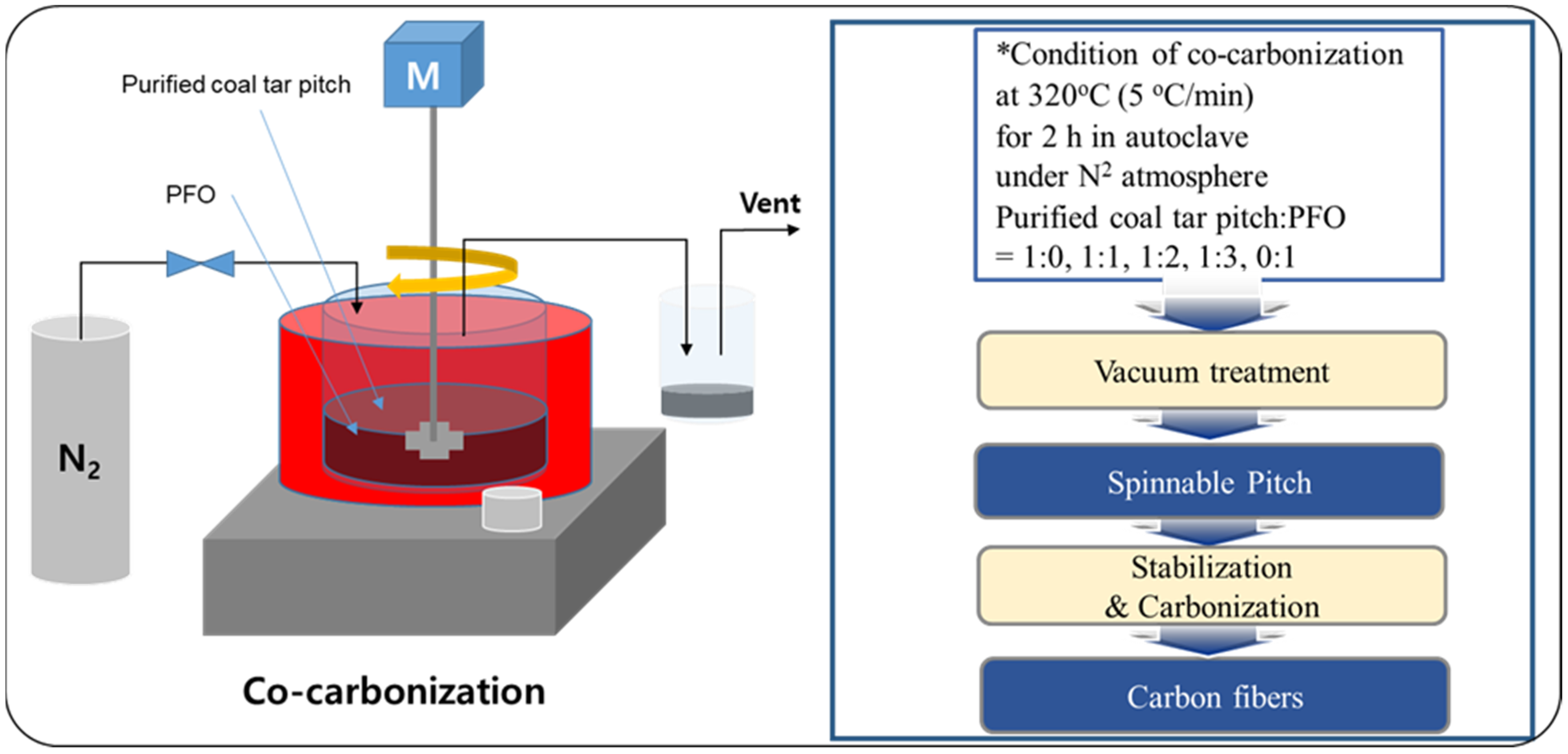
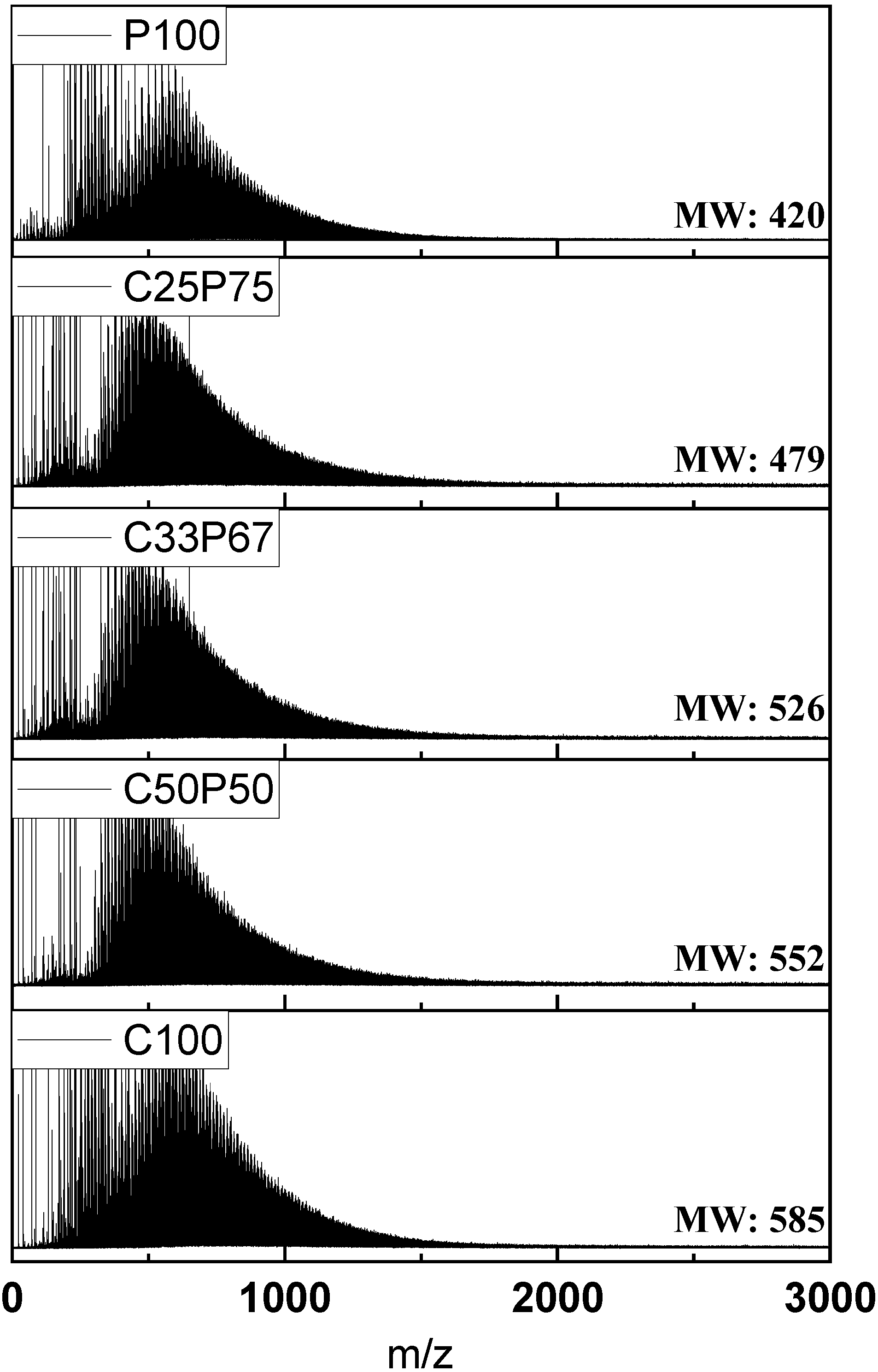
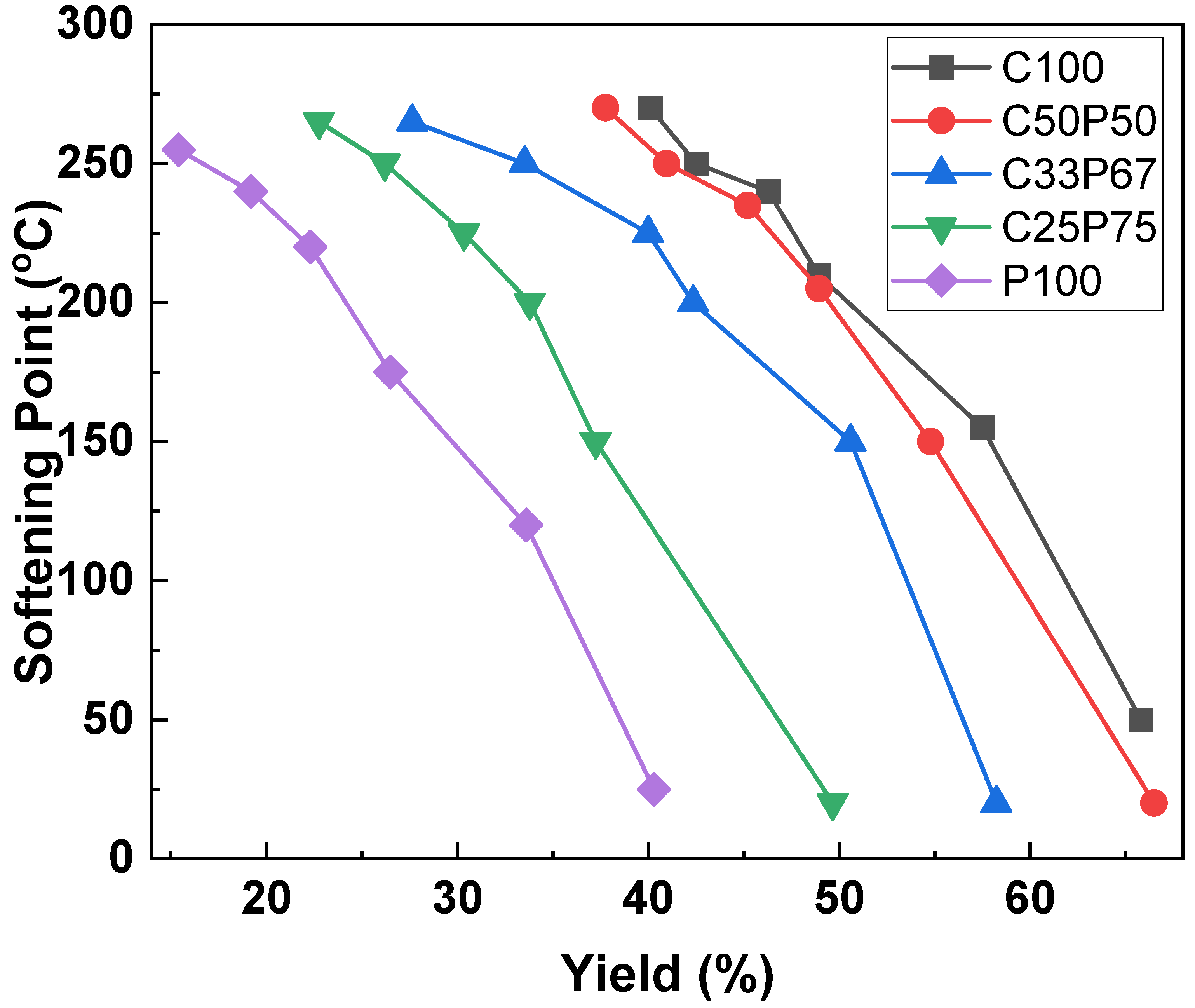
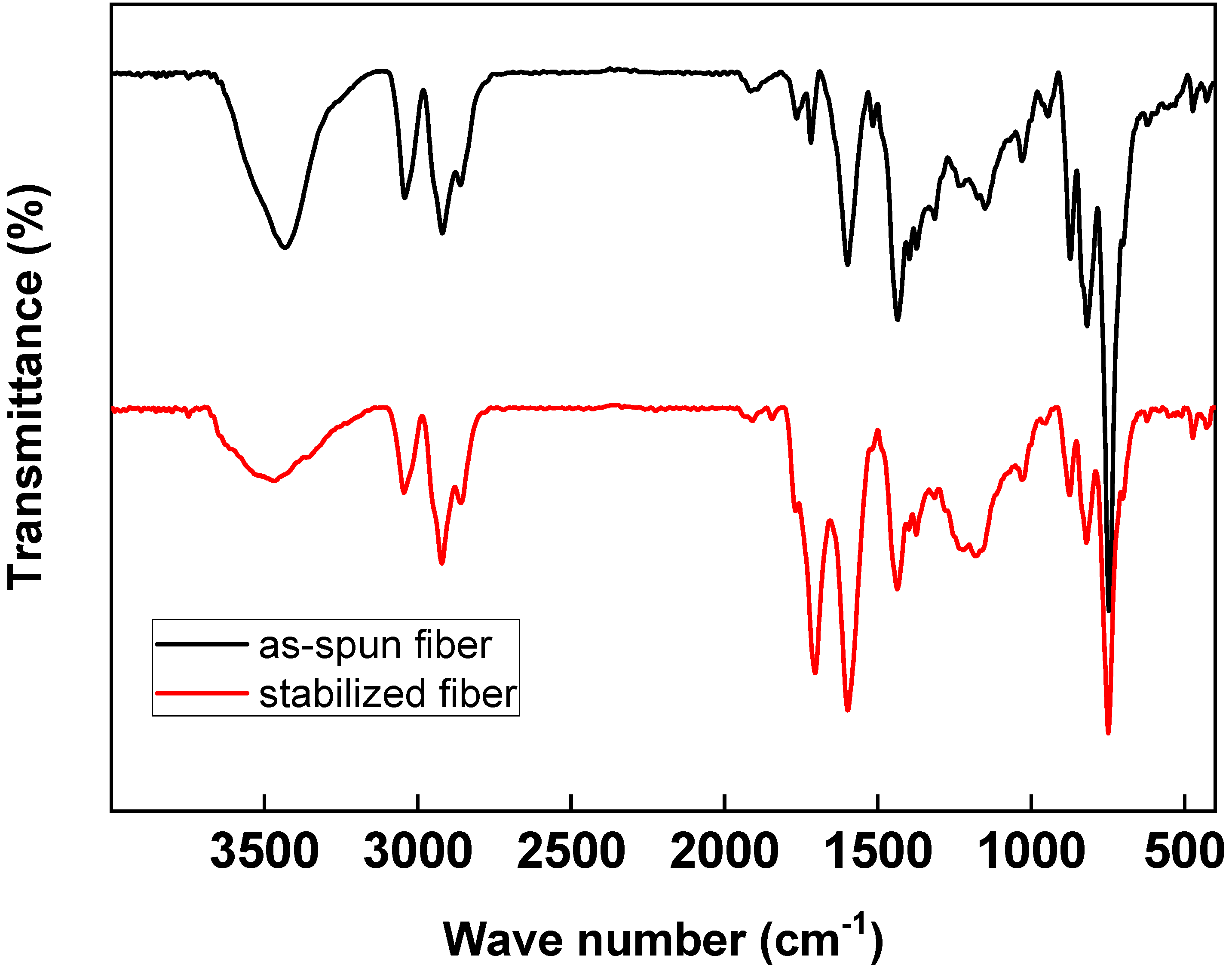
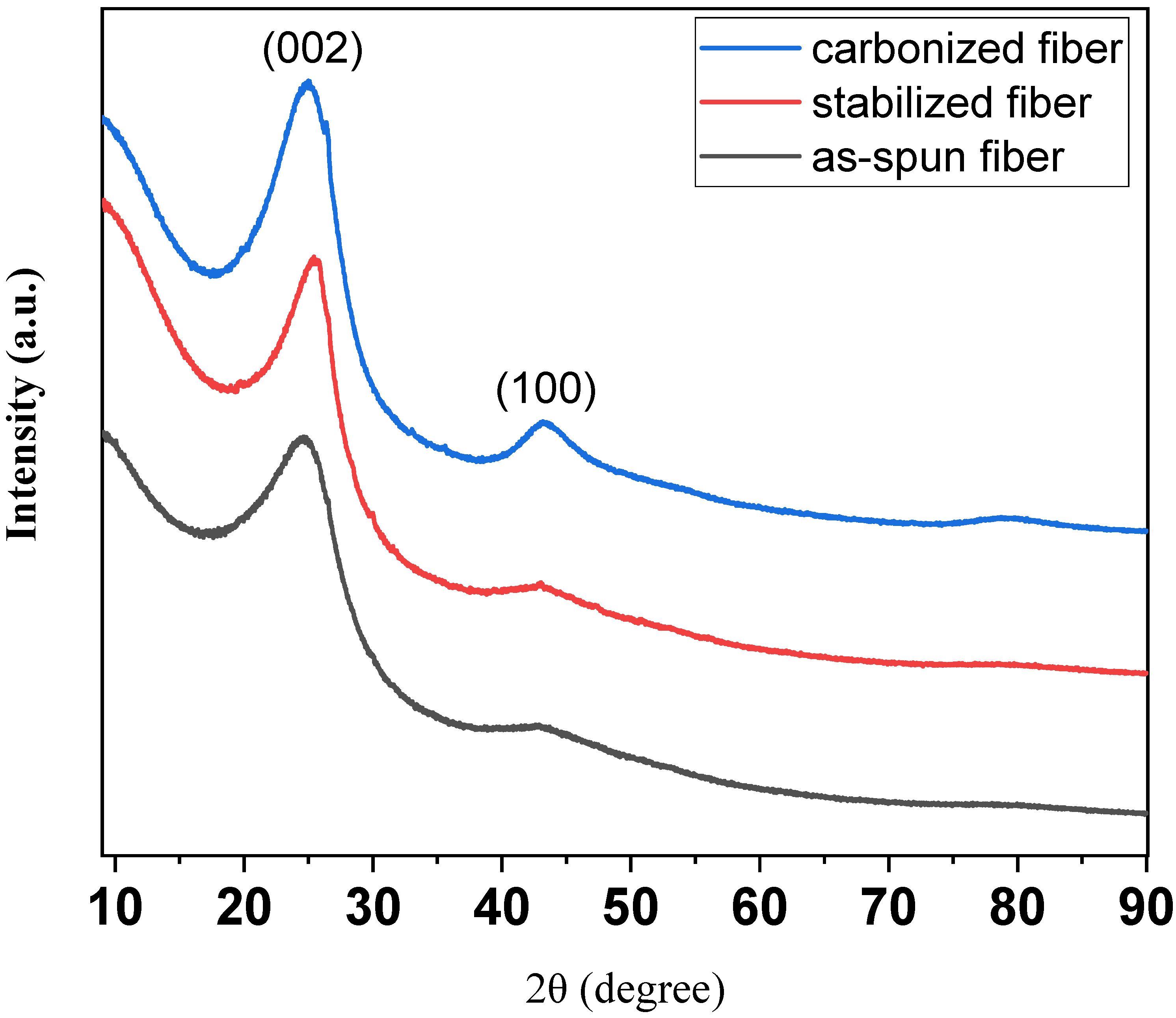
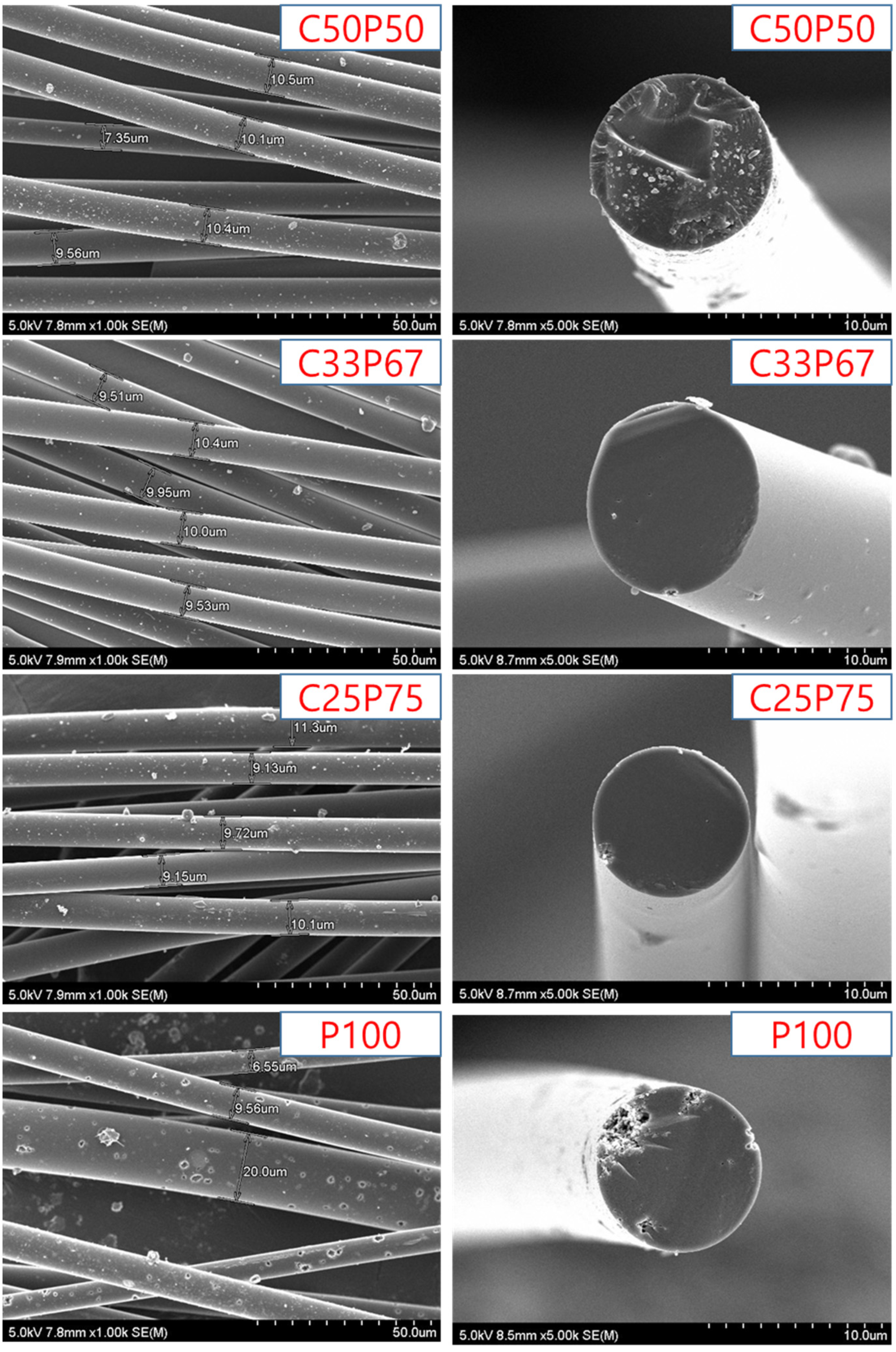

| Elemental Analysis | |||||
|---|---|---|---|---|---|
| C (wt%) | H (wt%) | N (wt%) | O (wt%) | S (wt%) | |
| Coal tar pitch | 86.9 | 6.1 | 1.5 | 4.9 | 0.5 |
| PFO | 90.3 | 7.9 | 1.6 | 0.1 | 0.1 |
| Type | Vacuum Heat Treatment Temp. (°C) | Maintain (min) | Final Yield (%) (Pristine to Final Pitch) | Softening Point (°C) |
|---|---|---|---|---|
| Centrifugation (Kerosene) | 200 | 10 | 81.1 | 100 |
| 250 | 10 | 74.6 | 160 | |
| 350 | 10 | 52.4 | 250 | |
| Solvent extraction (THF) | 200 | 10 | 64.8 | 80 |
| 250 | 10 | 55.1 | 140 | |
| 350 | 10 | 40.3 | 190 | |
| 360 | 5 | 33.1 | 250 |
| Sample Name | Ratio (wt.%) | Elemental Analysis (wt.%) | fa* | Mw | |||||
|---|---|---|---|---|---|---|---|---|---|
| Pitch | PFO | C | H | N | S | O | |||
| C100 | 100 | - | 92.8 | 4.2 | 1.2 | 0.4 | 1.4 | 99.9 | 585 |
| C50P50 | 50 | 50 | 92.0 | 5.7 | 0.6 | 0.2 | 1.5 | 95.1 | 552 |
| C33P67 | 33 | 67 | 92.0 | 6.2 | 0.5 | 0.1 | 1.2 | 92.6 | 526 |
| C25P75 | 25 | 75 | 92.0 | 6.4 | 0.3 | 0.1 | 1.2 | 90.3 | 479 |
| P100 | - | 100 | 90.3 | 7.9 | 1.6 | 0.1 | 0.1 | 80.9 | 420 |
| Spinnable Pitch | Winding Speed (RPM) | SP | Number of Fiber Breakage (for 5 min) | |
|---|---|---|---|---|
| Before | After | |||
| C100 | 500 | 250 | 250 | Impossible |
| C50P50 | 500 | 250 | 250 | 5 |
| C33P67 | 500 | 250 | 250 | 0 |
| C25P75 | 500 | 250 | 255 | 0 |
| P100 | 500 | 240 | 250 | 0 |
| Isotropic Pitch-Based Carbon Fiber Samples | Average Dimeter (μm) | Tensile Strength (MPa) | Elongation (%) | Modules (GPa) | Reference |
|---|---|---|---|---|---|
| C50P50 | 10 | 870 | 2.21 | 51.5 | |
| C33P67 | 9 | 1000 | 2.85 | 65.6 | |
| C25P75 | 10 | 820 | 1.85 | 37.4 | |
| Petroleum pitch-based | 11 | 700 | 1.65 | 22.5 | |
| 15 | 650 | - | - | [34] | |
| 30 | 210 | - | 22.0 | [35] | |
| 11 | 820 | 2.05 | 40.3 | [36] | |
| Coal tar pitch-based | 14 | 920 | - | - | [37] |
| 17 | - | - | - | [38] | |
| 12 | 786 | - | - | [17] | |
| Lignin-based | 10 | 520 | - | 28.6 | [39] |
| 33 | 458 | 0.79 | 59.0 | [40] | |
| 8 | 660 | 1.63 | 40.7 | [41] | |
| Hyper-coal-based | 7 | 800 | - | - | [19] |
| 8 | 1350 | - | - | [42] |
Publisher’s Note: MDPI stays neutral with regard to jurisdictional claims in published maps and institutional affiliations. |
© 2021 by the authors. Licensee MDPI, Basel, Switzerland. This article is an open access article distributed under the terms and conditions of the Creative Commons Attribution (CC BY) license (https://creativecommons.org/licenses/by/4.0/).
Share and Cite
Lee, S.H.; Lee, S.M.; Park, S.; Yoon, S.-H.; Han, H.; Jung, D.-H. Preparation of Isotropic Carbon Fibers from Kerosene-Purified Coal Tar Pitch by Co-Carbonization with Pyrolysis Fuel Oil. Materials 2021, 14, 6280. https://doi.org/10.3390/ma14216280
Lee SH, Lee SM, Park S, Yoon S-H, Han H, Jung D-H. Preparation of Isotropic Carbon Fibers from Kerosene-Purified Coal Tar Pitch by Co-Carbonization with Pyrolysis Fuel Oil. Materials. 2021; 14(21):6280. https://doi.org/10.3390/ma14216280
Chicago/Turabian StyleLee, Seon Ho, Song Mi Lee, Seungjoo Park, Seong-Ho Yoon, Haksoo Han, and Doo-Hwan Jung. 2021. "Preparation of Isotropic Carbon Fibers from Kerosene-Purified Coal Tar Pitch by Co-Carbonization with Pyrolysis Fuel Oil" Materials 14, no. 21: 6280. https://doi.org/10.3390/ma14216280






